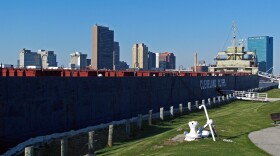Traffic is down at the Soo Locks. Demand for iron ore and other commodities is down compared to last year. But some Great Lakes shipping companies are beginning to see things get a little bit better.
“We are starting to see a rebound from where we were in the summer time,” says Lake Carrier Association spokesperson Eric Peace. “[Demand] is starting to move up for iron ore, limestone and some of the other commodities as well."
Cargo shipments of iron ore through November are down nearly 25% compared to 2019, while limestone cargo tonnage is down 16%, according to the Lake Carriers Association, a trade group representing 11 member companies operating 46 commercial cargo vessels on the Great Lakes.
Demand is creeping up only after a long and difficult year when the manufacturing industry temporarily shut down due to the coronavirus pandemic.
Peace says American shipping companies transported nearly 90 million tons of cargo total in 2019. Through November this year there’s been 36.6 million tons of iron ore shipped, and about 25.5 million tons of limestone.
Canadian and American carriers – the massive, long freighters sometimes visible on a Great Lakes horizon – traverse the Great Lakes and St. Lawrence Seaway hauling cargo to and from ports in both countries. Data from the Lake Carriers Association is a view of just one aspect of the shipping industry, as its members are made up of American carriers focused primarily on transporting iron ore and limestone.
According to the U.S. Geological Survey, mines in Michigan and Minnesota shipped 98% of the “usable iron ore products” consumed by the steel industry in 2019 in the United States – an estimated value of $5.4 billion dollars.
58.1 million tons of cargo had passed through the Soo Locks as of Dec. 12, 2020, according to U.S. Army Corps of Engineers spokesperson Bill Dowell. The Locks processed more than 73.1 million tons of cargo in all of 2019.
Bruce Burrows is the President of the Chamber of Marine Commerce, a binational association of private sector companies in the maritime industry. The association says cargo totals for both American and Canadian carriers on the St. Lawrence Seaway (not including the greater Great Lakes region) are down 6.6% compared to 2019. He says shipping on the St. Lawrence Seaway constitutes about 25% of all commercial shipping in the Great Lakes region.
“It’s been a super difficult year under the cloud of the pandemic, and we started off in much deeper, negative territory earlier in the season, finishing up Q2,” he says.
Burrows says closer to years’ end, demand for iron is down about 15% on the St. Lawrence Seaway, while dry bulk is down about 15%, and demand for refined [petroleum] products is down about 32%.
“You know, with construction shutdowns through the manufacturing sector [in early 2020], that’s particularly affected demand for steel,” Burrows says. “We move a lot of iron ore and steel in our system and that remains down.”
But grain has been a surprising boon this year for freight carriers on the St. Lawrence Seaway. Burrows says U.S. grain shipping volumes are up 20%, and Canadian grain is even higher than that. He says there’s global demand for grain products like pasta.
“The pandemic, people are at home, you know, eating macaroni and cheese,” Burrows says. “That’s been very helpful for us, but still hasn’t compensated for the loss in those other areas I mentioned. It’s still pretty healthy losses compared to 2019.”
There are more than 120,000 American jobs directly tied to the shipping industry across the Great Lakes region, according to a 2019 study by PricewaterhouseCoopers on behalf of the Transportation Institute. And according to the Great Lakes Seaway Institute, the Great Lakes shipping industry provides Michigan residents with over 25,000 jobs and more than $1.78 billion in personal income.
While the American members of the Lake Carriers Association transport mostly iron and limestone, Burrows says grain is buoying some businesses.
“Each port has a slightly different story depending on how focused they are on grain or not,” Burrows says. “Ports like Thunder Bay have not had as good a year in twenty years. Ports like Duluth, are very focused on iron ore movements and so on; they’ve had a really tough time.”






